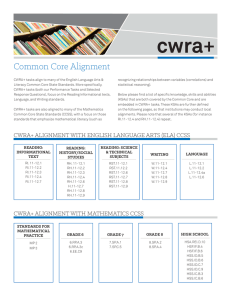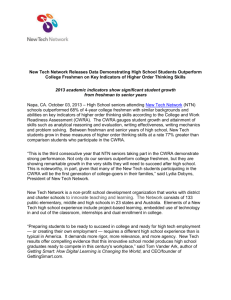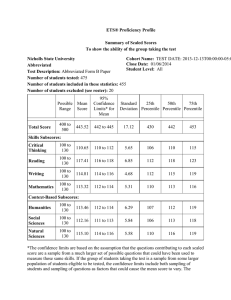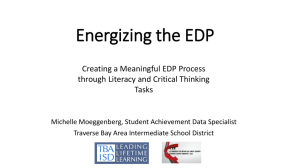cwra+ - Council for Aid to Education
advertisement
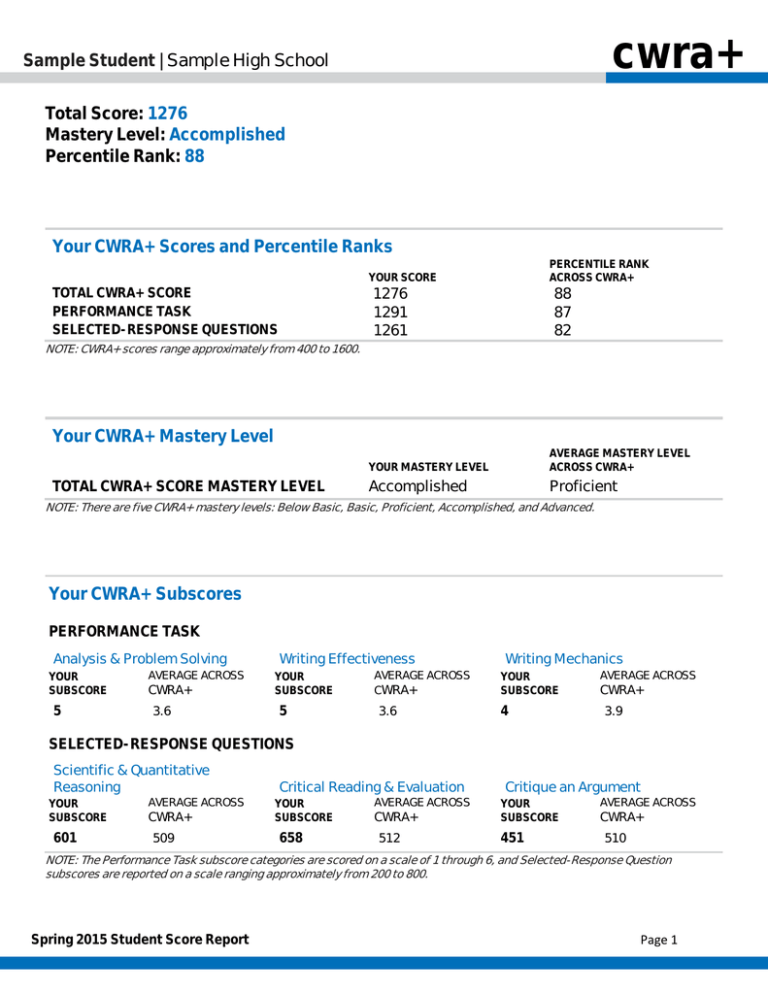
cwra+ Sample Student | Sample High School Total Score: 1276 Mastery Level: Accomplished Percentile Rank: 88 Your CWRA+ Scores and Percentile Ranks PERCENTILE RANK ACROSS CWRA+ YOUR SCORE TOTAL CWRA+ SCORE PERFORMANCE TASK SELECTED-RESPONSE QUESTIONS 1276 1291 1261 88 87 82 NOTE: CWRA+ scores range approximately from 400 to 1600. Your CWRA+ Mastery Level TOTAL CWRA+ SCORE MASTERY LEVEL YOUR MASTERY LEVEL AVERAGE MASTERY LEVEL ACROSS CWRA+ Accomplished Proficient NOTE: There are five CWRA+ mastery levels: Below Basic, Basic, Proficient, Accomplished, and Advanced. Your CWRA+ Subscores PERFORMANCE TASK Analysis & Problem Solving YOUR SUBSCORE 5 AVERAGE ACROSS CWRA+ 3.6 Writing Effectiveness YOUR SUBSCORE 5 AVERAGE ACROSS CWRA+ 3.6 Writing Mechanics YOUR SUBSCORE 4 AVERAGE ACROSS CWRA+ 3.9 SELECTED-RESPONSE QUESTIONS Scientific & Quantitative Reasoning YOUR SUBSCORE 601 AVERAGE ACROSS CWRA+ 509 Critical Reading & Evaluation YOUR SUBSCORE 658 AVERAGE ACROSS CWRA+ 512 Critique an Argument YOUR SUBSCORE 451 AVERAGE ACROSS CWRA+ 510 NOTE: The Performance Task subscore categories are scored on a scale of 1 through 6, and Selected-Response Question subscores are reported on a scale ranging approximately from 200 to 800. Spring 2015 Student Score Report Page 1 Sample Student | Sample High School cwra+ UNDERSTANDING YOUR RESULTS CWRA+, a product of CAE (the Council for Aid to Education, is an innovative assessment designed to measure critical-thinking and writtencommunication skills. CWRA+ includes two major components: a Performance Task (PT) and a series of SelectedResponse Questions (SRQs). The Performance Task presents students with a real-world situation that requires a purposeful written response. Students are asked to address an issue, propose the solution to a problem, or recommend a course of action to resolve a conflict. They are instructed to support their responses by utilizing information provided in a Document Library. This repository contains a variety of reference materials, such as technical reports, data tables, newspaper articles, office memoranda, and emails. A full PT includes four to nine documents in the library. Students have 60 minutes to complete this constructed-response task. In the second part of the examination, students are asked to answer 25 Selected-Response Questions. Ten questions measure scientific and quantitative reasoning, and ten measure critical reading and evaluation. Another five questions call for students to critique arguments by identifying logical flaws and questionable assumptions. Like the PT, the 25 SRQs are document-based and require students to draw information from provided materials. Students have 30 minutes to complete this section of the assessment. YOUR CWRA+ SCORES AND PERCENTILE RANKS The scores in the first table of your results represent your performance on the two sections of CWRA+ and on the assessment as a whole. corresponds approximately to the combined SAT Math and Critical Reading score range of college freshmen. Your Score for the Total CWRA+ is the average of the Performance Task and Selected-Response Questions section scores. Your CWRA+ section scores are determined by your subscores for the CWRA+ tasks, which are aggregated and converted to scale scores. This process results in a scale score distribution with the same mean and standard deviation as the combined SAT Math and Critical Reading (or converted ACT) scores of college freshmen that took CWRA+. This type of scaling makes it such that the CWRA+ score range CWRA+ scores typically range from roughly 400 to 1600, though it is possible for individuals with exceptionally high performance on the assessment to receive scores above 1600. The Percentile Rank Across CWRA+ column in the first table of this report indicates how well you performed on CWRA+ relative to other test-takers. The values in this column represent the percentage of examinees at your class level whose scores were lower than yours across CWRA+. MASTERY LEVELS Your CWRA+ mastery level is presented in the second table on page 1. These levels are determined by your Total CWRA+ score. There are five mastery levels for CWRA+: Below Basic, Basic, Proficient, Accomplished, and Advanced. Spring 2015 Student Score Report Students who are Below Basic do not meet the minimum requirements to merit a basic level of mastery. Page 2 Sample Student | Sample High School Students at the Basic level create responses that state or imply a decision, conclusion, or position and provide some analysis that may be minimal, inaccurate, or irrelevant. A basic student would provide an argument with some supporting information from sources and an attempt to cohesively organize that argument. Yet, the elaboration is limited and the organization lacks sufficient cohesion and clarity. For the basic student, severe errors are infrequent, but there are minor errors that sometimes interfere with meaning. The basic student also writes sentences that are similar in structure in length, with an overreliance on sentences with simple structure. The basic student draws obvious inferences from sources, rarely recognizes relevant information, and takes all information at face value. Analysis and Problem Solving and Writing Effectiveness are more important than Writing Mechanics in making the cut score decision for the Basic student. Students at the Proficient level have the ability to make inferences from the document and provide some support for the position, but may omit some evidence. They address most elements of the task, although sometimes tangentially. Students make a few accurate claims about the quality of evidence while citing the evidence provided in the documents. However, their responses may contain a few misinterpretations of the information and evidence provided in the documents. The students at the Proficient level are writing generally understandable sentences with minor errors and use the conventions of standard written English. The student responses are communicated in a way that is readily comprehensible. For Proficient students, there is an evaluation of the relative value of common logical strategies (e.g., bad cause and effect). They extract meaningful information and recognize utility from basic graphs and are able to draw conclusions from them. There is an understanding of correlation versus causality, as well as a basic understand of the design of the experiment. Proficient students will know what makes a credible scientific claim and provide an appropriate critical evaluation of sources. Students at the Accomplished level of mastery have the ability to make inferences from the document and provide sufficient evidence (based on multiple sources) to support their claim. This would include generating accurate interpretations of the document library, developing coherent arguments using much Spring 2015 Student Score Report cwra+ of the information provided in the documents, and potentially identifying, but not fully developing potential future steps and the need for additional research. They are also able to identify and address bias when making inferences or drawing conclusions, assess the relevancy of the qualitative and quantitative data (e.g., read and understand a graph and identify limitations and shortcomings; demonstrate an understanding that correlation does not necessarily imply causality), distinguish credible versus non-credible sources of information, and generate counter-claims. Accomplished students state a decision/recommendation/position and develop their argument based upon the identified information; however, they fall short of using evidence to fully support and leverage their argument. They have the ability to identify and extend the impact of the supporting versus counterevidence and their broader implications. Accomplished students write responses that are cohesive, organized, and elaborated effectively. The accomplished student recognizes the correct audience and writes in a way that demonstrates understanding of the intended audience. The sources (documents) of evidence in support of intent is clear and the organization or the argument and understanding it represents is accurate and logical. There may be some minor spelling and syntax errors, but the sentences are generally wellconstructed with varying and sometimes advanced vocabulary and structure, communicating a level of sophistication in the response. Students at the Advanced level discern the merit of information and evaluate the strength of arguments, including identifying bias. They demonstrate a thorough evaluation of the evidence by making connections between the information found in the documents, potentially identifying patterns, and if applicable refuting false or weak claims, which potential further steps either a next step moving forward or additional research that is needed or would be helpful. In order to strengthen their own arguments, students at the advanced level also address counter-arguments and demonstrate the weaknesses of the counter-arguments and/or the ways in which they those arguments are less compelling. Advanced students provide a decision or recommendation, with thorough support of their arguments articulated in an effective way. The evidence is thoroughly examined including addressing and navigating contradictory Page 3 cwra+ Sample Student | Sample High School responses and their interpretation of the documents is comprehensive. They fully respond to the prompt. writing is precise, purposeful, uses a varied vocabulary, sentence structure and length, and is free or almost entirely free from mechanical error. Their responses are organized in a fluid, coherent, and engaging way. It is easy to follow the students arguments, which also have the correct audience in mind and appropriately address them. They use the correct genre to deliver their responses, whether in a blog response, report, memo, speech, etc. Advanced students should be able to consistently reason analytically and solve problems and be able to understand nuances when integrating information across multiple sources. YOUR CWRA+ SUBSCORES Performance Task responses are scored across three skill areas: Analysis & Problem Solving, Writing Effectiveness, and Writing Mechanics. Each of these subscore categories is scored on a scale of 1 through 6. For information about the skills associated with each subscore, please refer to the CWRA+ Performance Task scoring rubric, which is available on our website at www.cae.org/cwraptrubric. The top section of the Your Subscores table on page 1 of this report shows your Performance Task subscore in each skill area, as well as the average subscore at your grade level across CWRA+. Selected-Response Questions are also scored across three skill areas: Scientific & Quantitative Reasoning, Critical Reading & Evaluation, and Critique an Argument. Subscores for the selectedresponse section of CWRA+ are determined by the number of correct answers in a given section, adjusted for the difficulty of the set of questions received, and then converted to a more interpretable scale using a linear transformation, with a mean of 500 and standard deviation of 100. This scale results in selected-response section subscores ranging from approximately 200 to 800, similar to the subsections of the SAT. The lower section of the Your Subscores table on page 1 of this report shows your Selected-Response Questions subscores, as well as the average subscore at your grade level across CWRA+. MOVING FORWARD SHARING RESULTS WITH COLLEGES OR EMPLOYERS Whether you intend to enroll in college, enter the workforce, or apply for an internship, individual results on CWRA+ provide a valuable tool for potential colleges or employers to ascertain the -thinking and writing skills. In addition to the Total CWRA+ Score, your percentile rank indicates how your score ranks against others across CWRA+, and your mastery level provides details about the skills required to have scored at a given level. You can choose to supplement job, internship, or college applications by including these results total CWRA+ scores, percentile rankings, and mastery levels on your résumé. Spring 2015 Student Score Report If you have scored at the Proficient, Accomplished, or Advanced level on CWRA+, you will also be eligible to receive a verified digital badge. These badges allow college and career-ready students to stand out among their peers and appeal to colleges and companies seeking students or employees with the higher-order skills measured by CWRA+. A CWRA+ badge can be displayed via an online vault or backpack, an electronic résumé, or a LinkedIn profile. A badge supplements a college application and a résumé because it showcases a broad range of valued by colleges and universities, and that are transferable outside of the classroom and valid in the workplace. Page 4
